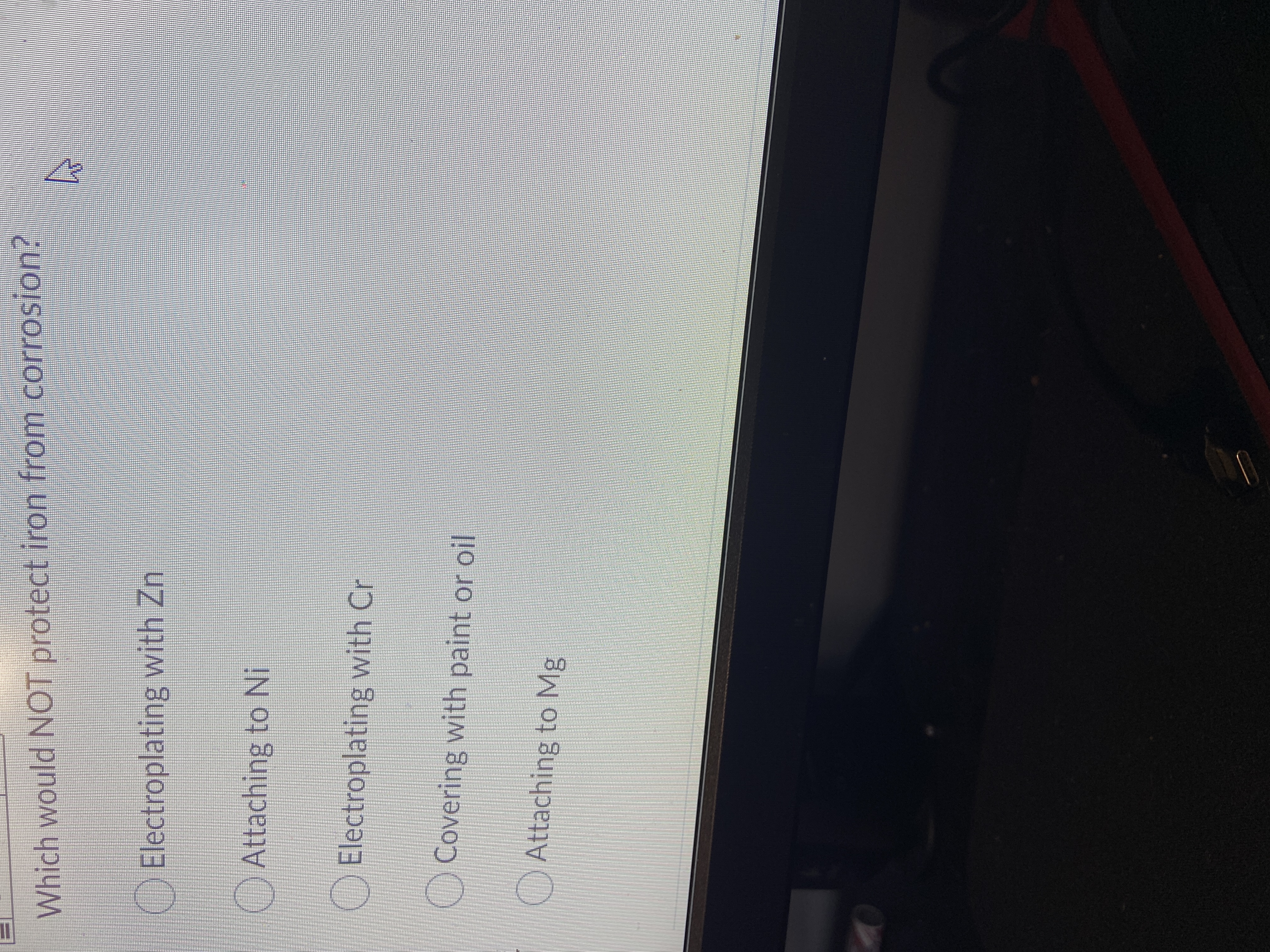
Principles of Modern Chemistry
8th Edition
ISBN: 9781305079113
Author: David W. Oxtoby, H. Pat Gillis, Laurie J. Butler
Publisher: Cengage Learning
expand_more
expand_more
format_list_bulleted
Question

Transcribed Image Text:Which would NOT protect iron from corrosion?
Electroplating with Zn
Attaching to Ni
Electroplating with Cr
O Covering with paint or oil
Attaching to Mg
Expert Solution
This question has been solved!
Explore an expertly crafted, step-by-step solution for a thorough understanding of key concepts.
This is a popular solution
Trending nowThis is a popular solution!
Step by stepSolved in 2 steps

Knowledge Booster
Learn more about
Need a deep-dive on the concept behind this application? Look no further. Learn more about this topic, chemistry and related others by exploring similar questions and additional content below.Similar questions
- In tables of standard reduction potentials that start from large positive values at the top and proceed through 0.0 V to negative values at the bottom, the alkali metals are normally at the bottom of the table. Use your chemical understanding of alkali metals and how they behave in bonding to explain why this is so.arrow_forwardConsider the electrolysis of a molten salt of some metal. What information must you know to calculate the mass of metal plated out in the electrolytic cell?arrow_forwardIf a plating line that deposits nickel (from NiCl2 solutions) operates at a voltage of 0.40 V with a current of 400.0 A and a total mass of 49.0 kg of nickel is deposited, what is the minimum number of kWh consumed in this process?arrow_forward
- An aqueous solution of an unknown salt of vanadium is electrolyzed by a current of 2.50 amps for 1.90 hours. The electroplating is carried out with an efficiency of 95.0%, resulting in a deposit of 2.850 g of vanadium. a How many faradays are required to deposit the vanadium? b What is the charge on the vanadium ions (based on your calculations)?arrow_forwardAluminum (E Al 3+/Al=2.07V) is more easily oxidized than iron (E Fe 3+/Fe=2.07V), and yet when both are exposed to the environment, untreated aluminum has very good corrosion resistance while the corrosion resistance of untreated iron is poor. Explain this observation.arrow_forwardCalculate the equilibrium constant for the following reactions using data from the standard reduction potential tables. (a) Cl2(g)+2Br-(aq)Br2(g)+2Cl-(aq) (b) Ni(s)+2Ag+(aq)2Ag(s)+Ni2+(aq) (c) I2(s)+Sn2+(aq)2I(aq)+Sn4+(aq)arrow_forward
- Consider the reducing agents Cu+(aq), Zn(s), and Fe(s). Which is strongest? Which is weakest?arrow_forwardConsider a galvanic cell for which the anode reaction is 3 Pb(s)Pb2+(1.0102M)+2e and the cathode reaction is VO2+(0.10M)+2H3O+(0.10M)+eV3+(1.0105M)+3H2O(l) The measured cell potential is 0.640 V. Calculate E for the VO2+V3+ half-reaction, usingE(Pb2+Pb) from Appendix E. Calculate the equilibrium constant (K) at 25°C for thereaction Pb(s)+2VO2+(aq)+4H3O+(aq)Pb2+(aq)+2V3+(aq)+6H2O(l)arrow_forwardConsider the following electrochemical cell: a. If silver metal is a product of the reaction, is the cell a galvanic cell or electrolytic cell? Label the cathode and anode, and describe the direction of the electron flow. b. If copper metal is a product of the reaction, is the cell a galvanic cell or electrolytic cell? Label the cathode and anode, and describe the direction of the electron flow. c. If the above cell is a galvanic cell, determine the standard cell potential. d. If the above cell is an electrolytic cell, determine the minimum external potential that must be applied to cause the reaction to occur.arrow_forward
- In the electrolysis of a solution containing Ni2+(aq), metallic Ni(s) deposits on the cathode. Using a current of 0.150 A for 12.2 minutes, what mass of nickel will form?arrow_forwardElectrolysis of an alkaline earth metal chloride using a current of 5.00 A for 748 s deposits 0.471 g of metal at the cathode. What is the identity of the alkaline earth metal chloride?arrow_forwardBalance the following oxidationreduction equations. The reactions occur in acidic or basic aqueous solution, as indicated. a MnO4+IMnO2+IO3(basic) b Cr2O32+ClCr3++Cl2(acidic) c S8+NO3SO2+NO(acidic) d H2O2+MnO4O2+MnO2(basic) e Zn+NO3Zn2++N2(acidic)arrow_forward
arrow_back_ios
SEE MORE QUESTIONS
arrow_forward_ios
Recommended textbooks for you
 Principles of Modern ChemistryChemistryISBN:9781305079113Author:David W. Oxtoby, H. Pat Gillis, Laurie J. ButlerPublisher:Cengage Learning
Principles of Modern ChemistryChemistryISBN:9781305079113Author:David W. Oxtoby, H. Pat Gillis, Laurie J. ButlerPublisher:Cengage Learning Chemistry: The Molecular ScienceChemistryISBN:9781285199047Author:John W. Moore, Conrad L. StanitskiPublisher:Cengage Learning
Chemistry: The Molecular ScienceChemistryISBN:9781285199047Author:John W. Moore, Conrad L. StanitskiPublisher:Cengage Learning Chemistry for Engineering StudentsChemistryISBN:9781337398909Author:Lawrence S. Brown, Tom HolmePublisher:Cengage Learning
Chemistry for Engineering StudentsChemistryISBN:9781337398909Author:Lawrence S. Brown, Tom HolmePublisher:Cengage Learning Chemistry & Chemical ReactivityChemistryISBN:9781337399074Author:John C. Kotz, Paul M. Treichel, John Townsend, David TreichelPublisher:Cengage Learning
Chemistry & Chemical ReactivityChemistryISBN:9781337399074Author:John C. Kotz, Paul M. Treichel, John Townsend, David TreichelPublisher:Cengage Learning Chemistry & Chemical ReactivityChemistryISBN:9781133949640Author:John C. Kotz, Paul M. Treichel, John Townsend, David TreichelPublisher:Cengage Learning
Chemistry & Chemical ReactivityChemistryISBN:9781133949640Author:John C. Kotz, Paul M. Treichel, John Townsend, David TreichelPublisher:Cengage Learning ChemistryChemistryISBN:9781305957404Author:Steven S. Zumdahl, Susan A. Zumdahl, Donald J. DeCostePublisher:Cengage Learning
ChemistryChemistryISBN:9781305957404Author:Steven S. Zumdahl, Susan A. Zumdahl, Donald J. DeCostePublisher:Cengage Learning

Principles of Modern Chemistry
Chemistry
ISBN:9781305079113
Author:David W. Oxtoby, H. Pat Gillis, Laurie J. Butler
Publisher:Cengage Learning

Chemistry: The Molecular Science
Chemistry
ISBN:9781285199047
Author:John W. Moore, Conrad L. Stanitski
Publisher:Cengage Learning

Chemistry for Engineering Students
Chemistry
ISBN:9781337398909
Author:Lawrence S. Brown, Tom Holme
Publisher:Cengage Learning

Chemistry & Chemical Reactivity
Chemistry
ISBN:9781337399074
Author:John C. Kotz, Paul M. Treichel, John Townsend, David Treichel
Publisher:Cengage Learning

Chemistry & Chemical Reactivity
Chemistry
ISBN:9781133949640
Author:John C. Kotz, Paul M. Treichel, John Townsend, David Treichel
Publisher:Cengage Learning

Chemistry
Chemistry
ISBN:9781305957404
Author:Steven S. Zumdahl, Susan A. Zumdahl, Donald J. DeCoste
Publisher:Cengage Learning